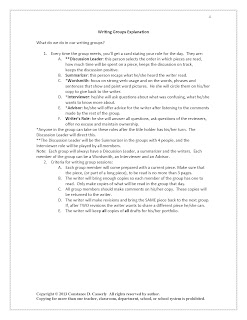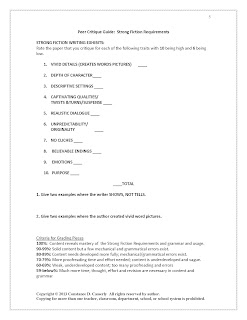
As teachers, one of our goals is to prepare our students for the world outside of the classroom by showing them how to express themselves verbally and in writing. The first part of that objective: verbally- is easier for the students and the teacher as it is less time-consuming and offers a smaller chance for criticism. The latter part-writing-is much more difficult because it takes time and effort and is out there for all to read and analyze.
Thinking about how long it will take to write down every word of every thought we want or are required to share is stressful enough. Add a visual of that blank sheet of paper-digital or hard copy- and Writers Block begins to tiptoe up our spines. Now, plug in the thought that other people will be reading what we wrote, that we don't have a chance to claim, "I never said that," or "That wasn't what I meant" like we can with the spoken word and full intimidation is likely to cause Writers Paralysis.
If we teachers who are accomplished writers can be intimidated by the thought of writing a paper that others will read, just think how daunted our students must feel when facing an assignment. Oh, we will always have students who must have swooped from the womb already penning his or her memoirs, who, innately are passionate, eager writers and face every assignment with vigor and confidence in their thinking/writing skills.
Mostly, though, we are joined on the Write Right Road by students who fall anywhere on the writing continuum from Not Proficient to Highly Proficient.
If we want our traveling companions to become strong writers, we must teach them to talk like writers (verbally and in writing) as well as showing them how to write right.
If we want our students to develop confidence in themselves as writers, we must Show them the characteristics of strong writing and Help them to find these strengths in their own writing as well as in others' words-authors they have never met and their peers- and then Let them critique their writing and their peers' pieces.
This week I have been following a National Council of Teachers of English discussion on LinkedIn, "Peer revision of essays- does it work with younger students" (http://www.linkedin.com/groupItem?view=&srchtype=discussedNews&gid=1228057&item=235589523&type=member&trk=eml-anet_dig-b_pd-ttl-cn&ut=18xo5sNfluNBI1). The man who introduced the topic says that he "struggles with this" on a college level and wondered if...and how... those who teach intermediate and high school deal with this segment of writing education.
Here's what I learned:
- If teachers are to incorporate peer critiquing, they must lay a foundation with specific criteria for their students to model in their writing and find in others.
- Many teachers have developed their own methods i.e. a read around or any that ask students to give positive feedback and then ask a question, or created/adapted one that fits their needs from their experience and from methods that colleagues use.
- Teachers need to decide if they want the critique sessions to be for editing others' writing or to make students aware of what constitutes strong writing for their own writing excursions, or both.
- Meaningful, specific rubrics. This need was stated often. Teachers must give students specific tasks, whether it be, "Give three examples hat moved you emotionally and explain how each one did this" to "Circle any misspelled words".
- Each level of instructors hopes that those teaching younger students will incorporate some form of peer revision because students who are confident talking about writing will become stronger writers.
In my experience, students biggest point of stress about critiquing stems from their fear that, "I won't find everything that you do"(the you being the teacher). We have to reassure them that they are not ever expected to do this, that they are to find points to praise and places to offer suggestions for improvement from their knowledge base. You don't need to explain that their editing and critiquing understanding will expand the more that they participate in this aspect of the writing process. This will just happen, and one day down the road, they will each have an AHA moment where they realize how much they have grown in their ability to talk the writers' talk as well as walk the writers' walk.
As a companion to today's blog, I am offering a 14-page FREEBIE: Incredible Critique
Forms and Rubrics: Twelve Individual
and Group Writing Assessment Handouts. Along with two full pages of Teachers Notes, you will find 12 Common Core Standards and Bloom's Taxonomy aligned printable handouts that students can use to analyze and critique their own writing as well as their peers. You can choose which ones best fit your students' skills, abilities and needs. I have used these various forms successfully with regular, Honors /A.P. and SPED students in grades 7-12. The Self-Assessment Sheet: Writing and the Quarter
Writing Progress Self-Assessment are great ways to help students take ownership for their writing and the process they choose to follow to complete their work.
Happy Teaching,








Don’t forget another good way of simplifying your writing is using external resources (such as HelpWriting.net ). This will definitely make your life more easier
ReplyDelete